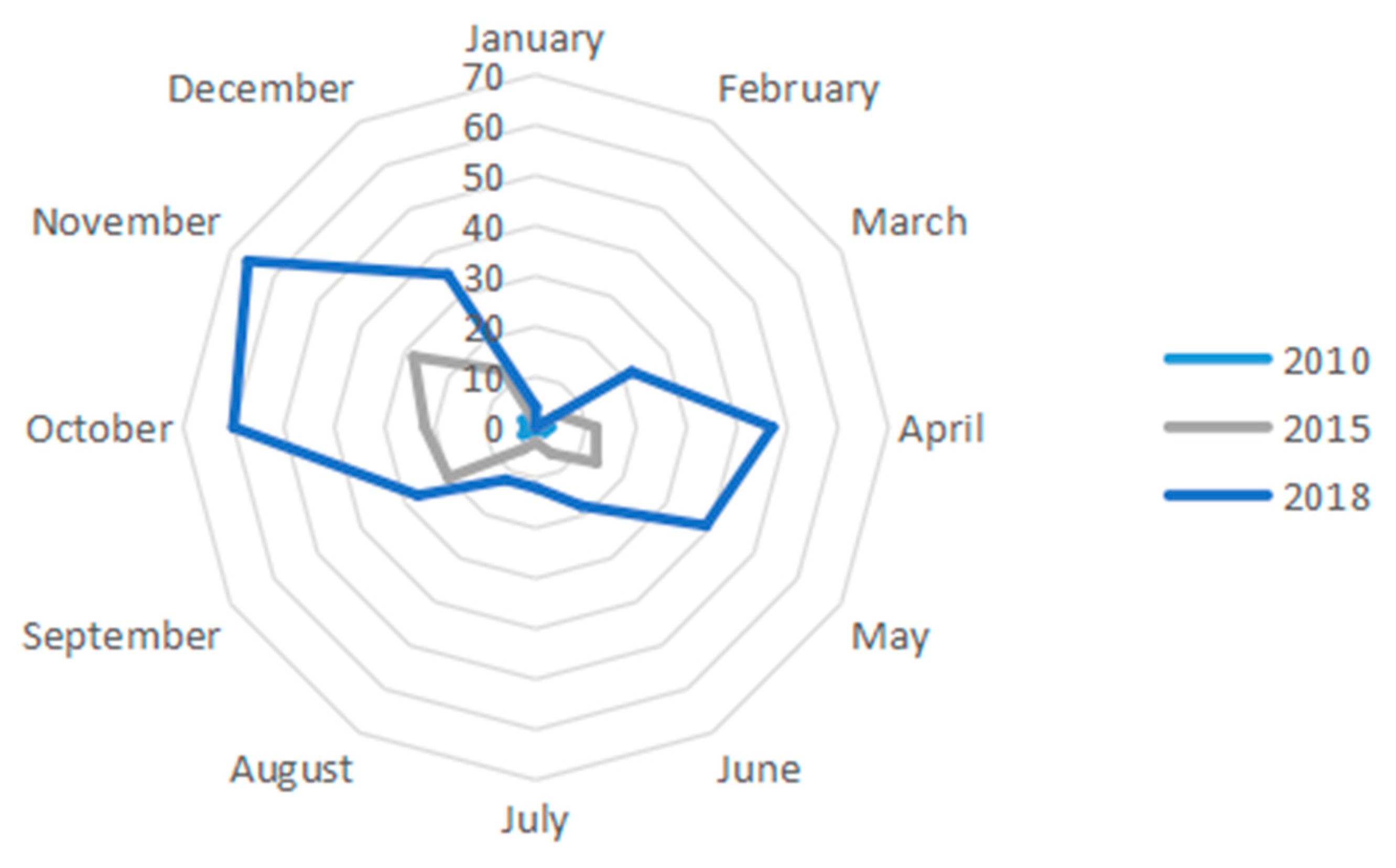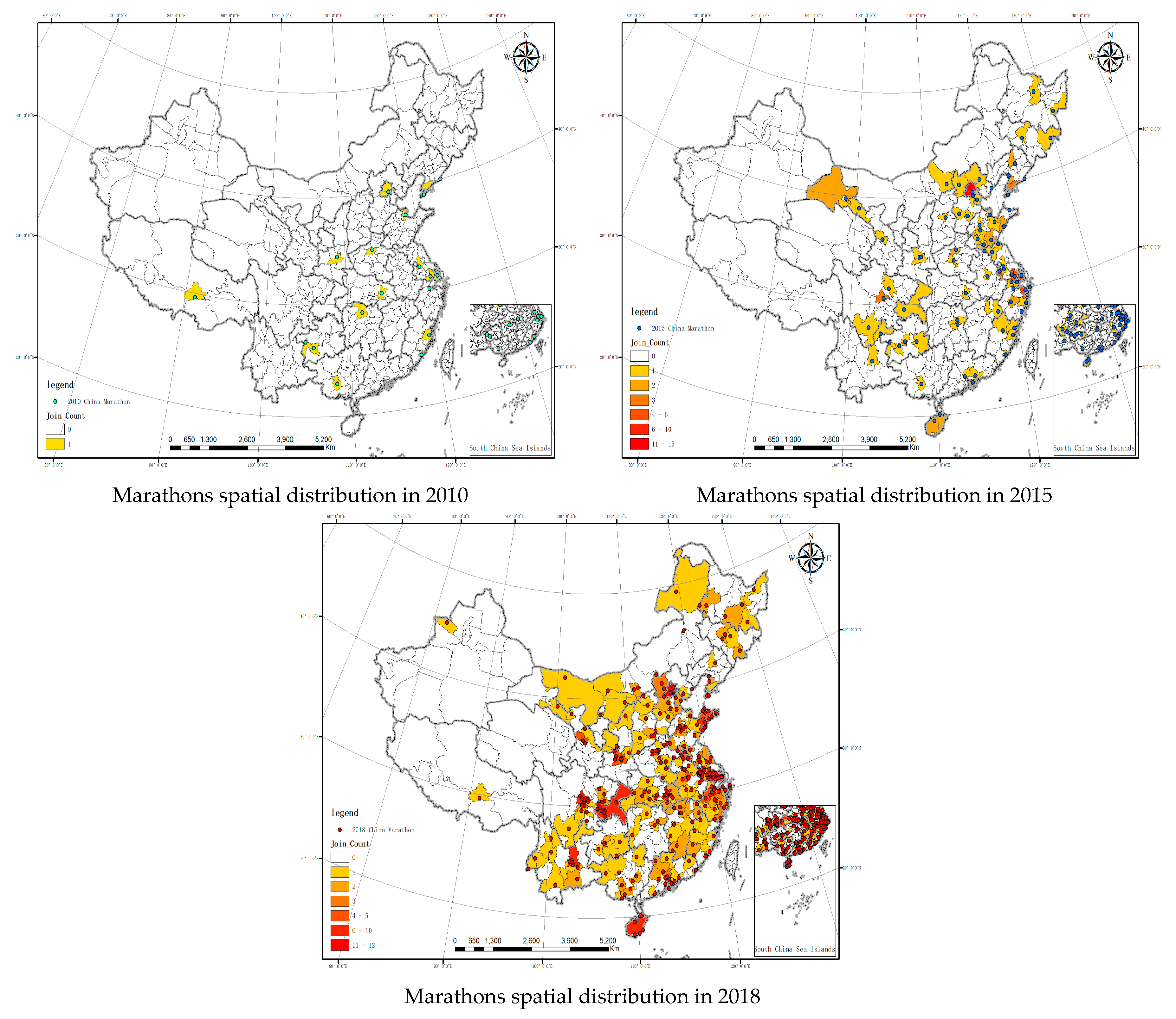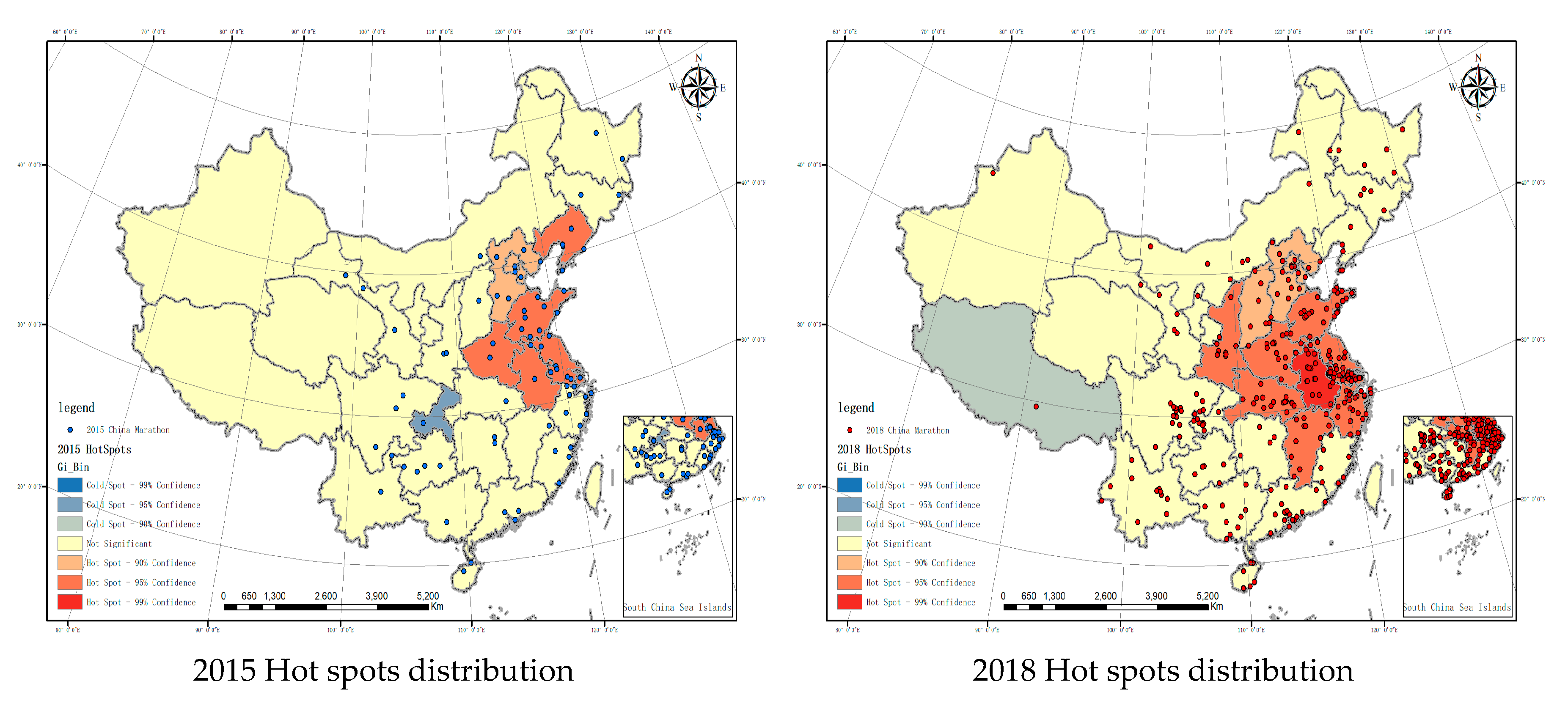The Temporal and Spatial Evolution of Marathons in China from 2010 to 2018
Abstract
1. Introduction
1.1. Background
1.2. Literature Review
1.3. Research Purpose
2. Materials and Methods
2.1. Data Sources
2.2. Research Methods
2.2.1. Average Nearest Neighbor Index
2.2.2. Spatial Autocorrelation (Global Moran’s I)
2.2.3. Kernel Density Analysis
2.2.4. Hot Spot Analysis
3. Results
3.1. The Temporal and Spatial Evolution of Marathons in China
3.2. Kernel Density Analysis of Marathons in China
3.3. Hot Spot Analysis of China Marathons
4. Discussion
4.1. Analysis of the Temporal and Spatial Evolution of Marathons in China
4.2. Development Characteristics of China Marathon at Various Stages
5. Conclusions
Author Contributions
Funding
Acknowledgments
Conflicts of Interest
References
- Eijsvogels, T.M.H.; Hoogerwerf, M.D.; Maessen, M.F.H.; Seeger, J.P.H.; George, K.P.; Hopman, M.T.E.; Thijssen, D.H.J. Predictors of cardiac troponin release after a marathon. J. Sci. Med. Sport 2015, 18, 88–92. [Google Scholar] [CrossRef] [PubMed]
- Radák, Z.; Ogonovszky, H.; Dubecz, J.; Pavlik, G.; Sasvari, M.; Pucsok, J.; Berkes, I.; Csont, T.; Ferdinandy, P. Super-marathon race increases serum and urinary nitrotyrosine and carbonyl levels. Eur. J. Clin. Investig. 2015, 33, 726–730. [Google Scholar] [CrossRef] [PubMed]
- Knechtle, B.; Nikolaidis, P.T. Physiology and Pathophysiology in Ultra-Marathon Running. Front. Physiol. 2018, 9, 634. [Google Scholar] [CrossRef] [PubMed]
- Tucker, R.; Santos-Concejero, J. The Unlikeliness of an Imminent Sub-2-Hour Marathon: Historical Trends of the Gender Gap in Running Events. Int. J. Sports Physiol. Perform. 2017, 12, 1017. [Google Scholar] [CrossRef] [PubMed]
- Cona, G.; Cavazzana, A.; Paoli, A.; Marcolin, G.; Grainer, A.; Bisiacchi, P.S. It’s a Matter of Mind! Cognitive Functioning Predicts the Athletic Performance in Ultra-Marathon Runners. PLoS ONE 2015, 10, e132943. [Google Scholar] [CrossRef] [PubMed]
- Buck, K.; Spittler, J.; Reed, A.; Khodaee, M. Psychological Attributes of Ultramarathoners. Wilderness Environ. Med. 2018, 29, 66–71. [Google Scholar] [CrossRef] [PubMed]
- Roebuck, G.S.; Fitzgerald, P.B.; Urquhart, D.M.; Ng, S.K.; Cicuttini, F.M.; Fitzgibbon, B.M. The psychology of ultra-marathon runners: A systematic review. Psychol. Sport Exerc. 2018, 37, 43–58. [Google Scholar] [CrossRef]
- Henst, R.H.; Jaspers, R.T.; Roden, L.C.; Rae, D.E. A chronotype comparison of South African and Dutch marathon runners: The role of scheduled race start times and effects on performance. Chronobiol. Int. 2015, 32, 858–868. [Google Scholar] [CrossRef]
- Jowett, G.E.; Hill, A.P.; Forsdyke, D.; Gledhill, A. Perfectionism and coping with injury in marathon runners: A test of the 2 × 2 model of perfectionism. Psychol. Sport Exerc. 2018, 37, 26–32. [Google Scholar] [CrossRef]
- Nikolaidis, P.T.; Knechtle, B. Performance in 100-km ultra-marathoners—At which age it reaches its peak? J. Strength Cond. Res. 2018. in print. [Google Scholar] [CrossRef]
- Zach, S.; Yan, X.; Zeev, A.; Arnon, M.; Choresh, N.; Tenenbaum, G. Motivation dimensions for running a marathon: A new model emerging from the Motivation of Marathon Scale (MOMS). J. Sport Health Sci. 2017, 6, 302–310. [Google Scholar] [CrossRef] [PubMed]
- Okayasu, I.; Nogawa, H.; Casper, J.M.; Morais, D.B. Recreational sports event participants’ attitudes and satisfaction: Cross-cultural comparisons between runners in Japan and the USA. Manag. Sport Leis. 2016, 21, 164–180. [Google Scholar] [CrossRef]
- Park, S.H.; Hsieh, C.M.; Miller, J.C. Moderating effects of recreation specialization on the quality-value-loyalty chain: A case of the Taroko Gorge Marathon. Int. J. Tour. Sci. 2018, 18, 29–42. [Google Scholar] [CrossRef]
- Cherrington, J.; Black, J.; Tiller, N. Running away from the taskscape: Ultramarathon as ‘dark ecology’. Ann. Leis. Res. 2018, 27, 1–21. [Google Scholar] [CrossRef]
- Podoler, G. Running in the Sun: The Pyongyang Marathon and its Evolution into a Sport Tourism Event. Int. J. Hist Sport 2016, 33, 2207–2225. [Google Scholar] [CrossRef]
- Lamont, M.; Kennelly, M. Sporting hyperchallenges: Health, social, and fiscal implications. Sport Manag. Rev. 2018, 22, 68–79. [Google Scholar] [CrossRef]
- Papadimitriou, D.; Kaplanidou, K.K.; Papacharalampous, N. Sport event-sponsor fit and its effects on sponsor purchase intentions: A non-consumer perspective among athletes, volunteers and spectators. J. Bus. Ind. Mark. 2016, 31, 247–259. [Google Scholar] [CrossRef]
- Go, F.M.; Chen, C.K.; Beek, R. How Three Japanese City Marathon Brands Overcame Double Jeopardy. Asian Sports Manag. Rev. 2016, 31, 249–259. [Google Scholar]
- Heck, S.; Terret, T. Nature conservation versus event organisation: ‘Madmen’s Diagonals’ on Reunion Island (1989–2014). J. Policy Res. Tour. Leis. Events 2016, 8, 18–32. [Google Scholar] [CrossRef]
- Zhaohuan, G.; Fenghua, S.; Gangyan, S.; Yajun, C. Effects of Different Beverages Consumption on 21 km Running Performance and Physiological Functions in Female Recreational Marathon Runners. Chin. J. Sports Med. 2017, 36, 226–231. [Google Scholar]
- Ming, Y.; Ye, T.; Jiexiu, Z. The Physiological and Biochemical Analysis of China Marathon Team Preparing for Berlin World Athletics Championships. China Sport Sci. Technol. 2011, 47, 21–25. [Google Scholar]
- Dapeng, Z. Mental cognition and regulation of amateur marathon participator in competition. J. Shandong Sport Univ. 2018, 34, 87–90. [Google Scholar]
- Yu, X.; Lin, C. The Sociological Metaphor of Marathon Craze. J. Sports Res. 2018, 1, 61–68. [Google Scholar]
- Wei, G.; Ziting, Q.; Junya, S. The Enlightenment of Kyoto Marathon on the Development of Xi’an Marathon under the Same City Culture Background Condition. J. Chengdu Sport Univ. 2019, 45, 73–79. [Google Scholar]
- Lin, Y.; Qin, X. Research on International Marathon and Urban Image Communication Strategy Based on Field Theory. J. Hunan Univ. Soc. Sci. 2019, 33, 147–152. [Google Scholar]
- Peng, M.; Liu, T.; Song, C. Study on the Collaborative Development of Marathon Events and Urban Culture under the Theory of Symbiosis. Sports Cult. Guide 2019, 6, 12–17. [Google Scholar]
- Wang, J. Leisure, Body and Self: Sociological Generating Logic of Popular Urban Marathon. J. Shenyang Sport Univ. 2019, 38, 39–44. [Google Scholar]
- Zhou, W.; Tian, H.; Qiu, Y. Qualitative Research on Serious Leisure Constrains Negotiation Strategies of Marathon Runners. J. Wuhan Inst. Phys. Educ. 2017, 51, 80–84. [Google Scholar]
- He, L.; Zhang, D. Operation Management and Development Countermeasures of China Gold Label Marathon Event. J. Beijing Sport Univ. 2019, 42, 88–100. [Google Scholar]
- Bai, L.; Feng, X. Research on the Status, Characteristics and Problems of Chinese Marathon Sponsorship Market. China Sport Sci. Technol. 2018, 54, 3–11. [Google Scholar]
- Chen, K.; Guo, Y.; Xu, H. The Spatial Distribution Characteristics and Influencing Factors of High-Level Marathon in China. J. Shanghai Univ. Sport 2018, 42, 36–41. [Google Scholar]
- Curebal, I.; Efe, R.; Ozdemir, H.; Soykan, A.; Sönmez, S. GIS-based approach for flood analysis: Case study of Keçidere flash flood event (Turkey). Geocarto Int. 2016, 31, 355–366. [Google Scholar] [CrossRef]
- Portugués-Mollá, I.; Bonache-Felici, X.; Mateu-Bellés, J.F.; Marco-Segura, J.B. A GIS-Based Model for the analysis of an urban flash flood and its hydro-geomorphic response. The Valencia event of 1957. J. Hydrol. 2016, 541, 582–596. [Google Scholar] [CrossRef]
- Pulidobosch, A.; Gisbert, J.; Alalwani, G.; Walling, D.E.; Probst, J.L. Environmental impact of development work in the ski resort of Sierra Nevada (Spain). Hum. Impact Eros. Sediment. 1997, 49–56. Available online: https://www.cabdirect.org/cabdirect/abstract/19981803359 (accessed on 10 October 2019).
- Du, P. Urban traffic safety analysis and assessment system based on GIS: System design, key techniques and implementation strategy. In Proceedings of the Geoinformatics & Joint Conference on Gis & Built Environment: The Built Environment & Its Dynamics, Guangzhou, China, 28–29 June 2008; Airiti Inc.: New Taipei City, Taiwan, 2008. [Google Scholar]
- Taubenbock, H.; Pengler, I.; Schwaiger, B.; Cypra, S. A multi-scale urban analysis of the Hyderabad metropolitan area using remote sensing and GIS. In Proceedings of the 2007 Urban Remote Sensing Joint Event, Paris, France, 11–13 April 2007. [Google Scholar]
- Vandersmissen, M.H.; Séguin, A.M.; Thériault, M.; Claramunt, C. Modeling propensity to move after job change using event history analysis and temporal GIS. J. Geogr. Syst. 2009, 11, 37. [Google Scholar] [CrossRef]
- Alananzeh, O.; Maaiah, B.; Albadarneh, M.; Alshorman, A. The geographic distribution of conferences in Jordan from 2014 to 2016 using predictive GIS modeling. J. Conv. Event Tour. 2017, 19, 167–185. [Google Scholar] [CrossRef]
- Bonazountas, M.; Kanellopoulos, S.; Schaller, J.; Kallidromitou, D.; Martirano, G. Gis & Visual Analytics on Grid Technology; Springer: Dordrecht, The Netherlands, 2009; pp. 287–297. [Google Scholar]
- Rem, J. Study on the Spatial and Temporal Distribution of China’s Marathon Events and Its Influencing Factors. Master’s Thesis, Shanghai Normal University, Shanghai, China, 2019. [Google Scholar]
- Huifang, Z.; Fuyong, W.; Mei, Y. The Cultural Meaning and Function of Marathon Sports. Sichuan Sports Sci. 2014, 33, 12–15. [Google Scholar]
- Lin, L.; Qiao, F. First Decade of IAAF Label Road Races Development (2008–2017). China Sport Sci. 2018, 38, 90–97. [Google Scholar]
- Chen, K.; Liu, X.; Yan, Q.; Zhang, X. Comprehensive Evaluation of the Competitiveness of Top Marathons Events in China. J. Tianjin Inst. Phys. Educ. 2017, 32, 473–480. [Google Scholar]
- Ren, X.; Xia, C. Theoretical and Empirical Study of Coordinated Development between the Competitiveness of China’s Sports Industry and the Economy Development. J. Shanghai Univ. Sport 2016, 40, 23–29. [Google Scholar]
- Chen, K.; Tang, W.; Li, J.; Ding, L. Spatial-Temporal Distribution of Chinese Top Professional Football Clubs from 1994 to 2013: Pattern and Evolution. J. Tianjin Inst. Phys. Educ. 2015, 30, 377–382. [Google Scholar]
- Lu, J.; Ni, G.; Xiong, J. Competitive Evaluation and Empirical Inquiry in Regional Sports Industry. China Sport Sci. 2009, 29, 28–38. [Google Scholar]
- Guclu, Y. The determination of sea tourism season with respect to climatical conditions on the black sea region of Turkey. Procedia-Soc. Behav. Sci. 2010, 19, 258–269. [Google Scholar] [CrossRef][Green Version]
- Brännäs, K.; Nordström, J. Tourist Accommodation Effects of Festivals. Tour. Econ. 2002, 12, 291–302. [Google Scholar] [CrossRef]
- Chen, T.; Pearce, P.L. Research note: Seasonality patterns in Asian tourism. Tour. Econ. 2012, 8, 1105–1115. [Google Scholar] [CrossRef]
- Ma, D.; Jiang, Y.; Zhu, Y. Study on the Distribution of Sports Intangible Cultural Heritage in China Based on GIS. China Sport Sci. 2015, 35, 19–24. [Google Scholar]
- Clark, P.J.; Evans, F.C. Distance to Nearest Neighbor as a Measure of Spatial Relationships in Populations. Ecology 1954, 35, 445–453. [Google Scholar] [CrossRef]
- Xu, D.; Huang, Z.; Lv, L.; Chen, X.; Cao, F. Research on Spatial Characteristic of Urban Leisure Tourism Based on POI Mining: A Case Study of Nanjing City. Geogr. Geo-Inform. Sci. 2018, 34, 59–64. [Google Scholar]
- Wang, D.; Fang, Y.; Qiu, P. Analysis on spatial distribution and influence of football clubs in china. Hum. Geogr. 2015, 30, 60–65. [Google Scholar]
- Janert, P.K. Gnuplot in Action: Understanding Data with Graphs; Tsinghua University Press: Beijing, China, 2012. [Google Scholar]
- Loo, B.P.Y.; Yao, S.; Wu, J. Spatial point analysis of road crashes in Shanghai: A GIS-based network kernel density method. In Proceedings of the 2011 19th International Conference on Geoinformatics, Shanghai, China, 24–26 June 2011. [Google Scholar]
- Abedi-Astaneh, F.; Hajjaran, H.; Yaghoobi-Ershadi, M.R.; Hanafi-Bojd, A.A.; Mohebali, M.; Shirzadi, M.R.; Rassi, Y.; Akhavan, A.A.; Mahmoudi, B. Risk Mapping and Situational Analysis of Cutaneous Leishmaniasis in an Endemic Area of Central Iran: A GIS-Based Survey. PLoS ONE 2016, 11, e161317. [Google Scholar] [CrossRef]
- Feng, H. The Development and Optimization of Urban Marathon Events in China. J. Nanjing Sport Inst. Soc. Sci. 2017, 31, 30–33. [Google Scholar]
- Zhao, Z. Essential Attribute and Morphological Characteristics of the Principal Social Contradiction Fa-cing Chinese Society in the New Era. J. Polit. Sci. 2018, 2, 55–65. [Google Scholar]




| Number of Events | City | Number of Events | City |
|---|---|---|---|
| 12 | Beijing | 8 | Wuxi/Wuhan/Chongqing |
| 10 | Nanjing | 7 | Shanghai |
| 9 | Chengdu/Suzhou/Zhengzhou | 6 | Hangzhou/Kunming/Qingdao, Shenzhen |
| 4 province tiers by the number of marathons | |||
| T-1 | Jiangsu | ||
| T-2 | Shandong, Henan, Anhui, Hubei, Zhejiang, Guangdong, Sichuan, Yunnan | ||
| T-3 | Hebei, Henan, Shaanxi, Jiangxi, Guangzhou, Fujian, Hainan, Heilongjiang, Jilin, Hunan, Inner Mongolia, Shanxi, Guizhou | ||
| T-4 | Xinjiang, Tibet, Ningxia, Liaoning | ||
| Year | ANND (km) | Nearest Neighbor Ratio | Z Score | p Value | Type |
|---|---|---|---|---|---|
| 2010 | 345.92 | 1.164714 | 1.336896 | 0.181257 | Random |
| 2015 | 66.60 | 0.502146 | −10.817515 | 0.0000 | Clustered |
| 2018 | 61.28 | 0.531149 | −16.587427 | 0.0000 | Clustered |
| Year | Moran’s I index | Z-Value | p Value | Z-Value Test Results |
|---|---|---|---|---|
| 2010 | −0.010165 | −0.541599 | 0.588095 | non-significant |
| 2015 | 0.066267 | 5.488973 | 0.000000 | 0.99 |
| 2018 | 0.083485 | 6.126412 | 0.000000 | 0.99 |
| Years | Hot Spot 99% Confidence | Hot Spot 95% Confidence | Hot Spot 90% Confidence | Cold Spot 90% Confidence | Cold Spot 95% Confidence |
|---|---|---|---|---|---|
| 2015 | Jiangsu, Anhui, Henan, Liaoning | Beijing, Tianjin, Hebei | Chongqing | ||
| 2018 | Anhui | Jiangxi, Hubei, Henan, Shaanxi, Shandong, Jiangsu, Shanghai, Zhejiang | Shaanxi, Beijing, Tianjin, Hebei | Tibet |
© 2019 by the authors. Licensee MDPI, Basel, Switzerland. This article is an open access article distributed under the terms and conditions of the Creative Commons Attribution (CC BY) license (http://creativecommons.org/licenses/by/4.0/).
Share and Cite
Zuo, Y.; Zou, L.; Zhang, M.; Smith, L.; Yang, L.; Loprinzi, P.D.; Ren, Z. The Temporal and Spatial Evolution of Marathons in China from 2010 to 2018. Int. J. Environ. Res. Public Health 2019, 16, 5046. https://doi.org/10.3390/ijerph16245046
Zuo Y, Zou L, Zhang M, Smith L, Yang L, Loprinzi PD, Ren Z. The Temporal and Spatial Evolution of Marathons in China from 2010 to 2018. International Journal of Environmental Research and Public Health. 2019; 16(24):5046. https://doi.org/10.3390/ijerph16245046
Chicago/Turabian StyleZuo, Yifan, Liye Zou, Mu Zhang, Lee Smith, Lin Yang, Paul D. Loprinzi, and Zhanbing Ren. 2019. "The Temporal and Spatial Evolution of Marathons in China from 2010 to 2018" International Journal of Environmental Research and Public Health 16, no. 24: 5046. https://doi.org/10.3390/ijerph16245046
APA StyleZuo, Y., Zou, L., Zhang, M., Smith, L., Yang, L., Loprinzi, P. D., & Ren, Z. (2019). The Temporal and Spatial Evolution of Marathons in China from 2010 to 2018. International Journal of Environmental Research and Public Health, 16(24), 5046. https://doi.org/10.3390/ijerph16245046







